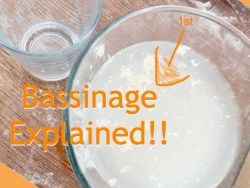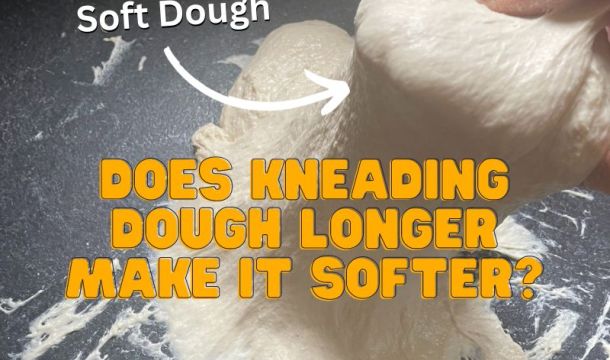
What Is Bassinage In Bread Baking?

The bassinage technique is a special baker’s trick that originates in France. It involves more effort and takes more time, but the results that bassinage produces are worth it! So, how does bassinage work?
What is the bassinage technique?
Eau de bassinage is an old French technique used when making bread dough. It loosely translates to “water that is bathed, moistened or added”.
When adding the ingredients to begin kneading, instead of adding all the water, around 5-15% is retained and held back.
The dough is kneaded, and once the gluten has almost reached its intended development, the second water addition is added.
Alternatively, when making sourdough or another type of long-fermented bread, the additional water is added midway through the first rise (bulk fermentation).
Why should I use bassinage?
Kneading hydrates the gluten bonds and strengthens the bonds between strands, which form the gluten matrix.
A stiff (less hydrated) dough takes on elastic properties once kneaded before the bassinage is added.
Whilst some of the second water is absorbed by the gluten and starch, a portion of it remains suspended in the dough.
The free water gets trapped between the gluten strands and forges a dough with an exciting combination of strength and an irregular structure.
The bassinage method increases the total amount of water the dough can retain, making it a fantastic technique when dealing with high-hydration doughs where an irregular and open cell structure appears is desired.
What bread can I use with the bassinage method?
Bassinage is often observed in bread that requires an open, soft crumb. I used this step in my authentic baguette recipe and my Italian ciabatta recipe.
I believe it’s what makes them so good! This method also helps sourdough bread have an open crumb.
Using bassinage when kneading
If bulk fermentation is under 4 hours, the bassinage is typically added near the end of kneading, once the dough has reached 70% development.
You can learn more about gluten development in the windowpane test guide.
How to do bassinage in a dough mixer
It’s much easier to use this technique when making the dough in a mixer. Here’s how it works:
1- When weighing your ingredients, separate 10% of the total water used in the recipe. Place it in a second bowl or jug.
2- Add the ingredients, excluding separated water and knead as usual until reaching 70% gluten development.
3- Reduce the speed to a slow knead.

4- Slowly pour the retained water.

4- Keep mixing until the water is at least ½ absorbed. This can take a few minutes!

5- Once the water isn’t going to splash out of the bowl, increase the speed of the mixer and knead until the water is absorbed. The gluten will stretch without tearing but still feel a little wet.

NOTE: In this example, gluten development will reach around 85%, with the remaining 15% occuring during bulk fermentation. If you make a no-time dough and skip the first rise, develop the dough to 85% gluten development before adding the bassinage.
How to do bassinage when hand-kneading
As in the previous example, remove 10% of the total water from the recipe.
Add the ingredients, except the bassinage water and knead the dough.
How to knead bread by hand
In my how to knead dough guide, I explain how I separate hand kneading into three stages. The first comprises of a gentle incorporation, lasting around 2-3 minutes. This is followed by 5-7 minutes of “slow” kneading and 5 minutes of “intensive” kneading.
Continue kneading until the dough has reached 75% gluten development.
Return the dough back to the mixing bowl and add the extra water. Start folding the dough into the water, but you can punch or bash it around as you wish! Just keep it moving!
Once the dough absorbs most of the water, take it onto the table and continue kneading it with stretching motions.
After a few minutes, the water will be incorporated, and the dough will be kneaded sufficiently.
Doing the bassinage in bulk fermentation
Kneading is kept to a minimum in sourdough bread dough. The long bulk fermentation period allows the gluten structure to appear without the need for much hard work!
Instead of adding the bassinage at the end of mixing, the water is introduced during the middle of bulk fermentation.
To gain the full benefits of bassinage, we should wait until the gluten has developed to at least 50%, but up to 70% development for sourdough is better. This is roughly the midway point of the first rise.
The second water can be gradually added in stages, or all in one go.
1- Remove 10% of the water and store it in a separate bowl or jug. Here, I added my starter to the first water.

2- Knead the dough gently for 3-5 minutes. Then, place it to rest in a covered container.
3- After 2 hours of bulk fermentation, add the water before a stretch and fold in the bowl.

4- Repeat the stretch and folds every 30 minutes for 2 hours.

5- The water will gradually absorb, and the dough is ready to shape after 3-4 folds.

How much water should be reserved in the bassinage?
5-15% of the total amount of water is typical for a bassinage, yet there is no hard rule for how much water you should hold back.
If you remove too much, you have a really dry dough that’s hard to knead, and the gluten can become damaged. Too little, and you won’t notice much benefit in the final bread.
For example: 800 grams of water = 760 grams + 40 grams
TIP: Some bakers include part of the salt from the recipe in their reserved water. There’s some science to support this and some against it! Try it out for yourself or ignore that I mentioned it and add all the salt at the start of mixing!
When shouldn’t I use bassinage?
If you are aiming for a close-knit crumb, typical of tin loaves and bread rolls, you wouldn’t want to use this method.
Kneading a low hydration dough is hard, so it’s easier just to add all the water in one go.
Bassinage takes time and effort and is generally a pain! In the industrial world, time costs money, so it’s not used in many commercial bakeries outside France.
I love to use it at home, and if you have a dough mixer, there’s little reason not to!
Ending thoughts on bassinage
I don’t use Bassinage for every bread recipe, nor should you. It’s to be kept in a back pocket and employed when it’s needed.
What do you think of bassinage? Have you used it before? Let me know in the comments below.
If you’ve enjoyed this article and wish to treat me to a coffee, you can by following the link below – Thanks x

Hi, I’m Gareth Busby, a baking coach, senior baker and bread-baking fanatic! My aim is to use science, techniques and 15 years of baking experience to make you a better baker.
Table of Contents
Related Recipes
Related Articles
Latest Articles
Baking Categories
Disclaimer
Address
53 Greystone Avenue
Worthing
West Sussex
BN13 1LR
UK







